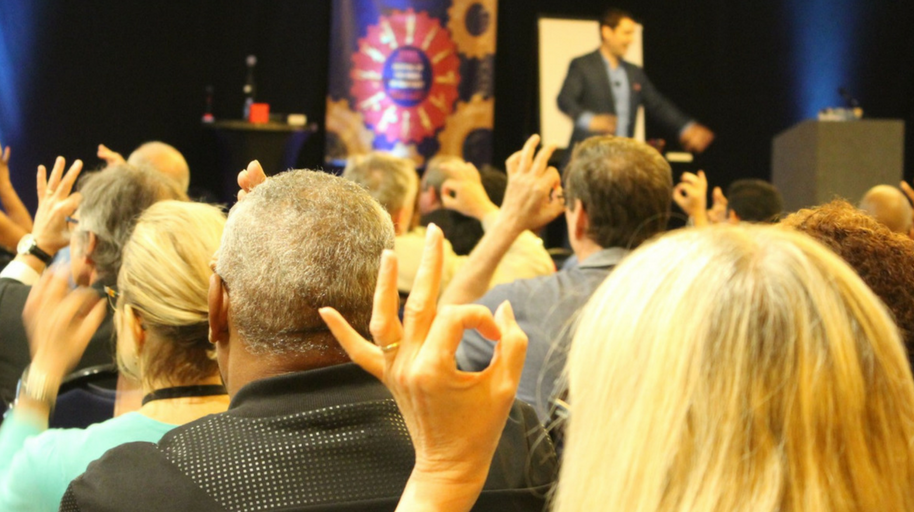
Photo courtesy of CWA
For over 20 years, the California Workforce Association has brought together a think tank of individuals from across the broad spectrum of workforce and economic development and education to consider outside points of view at Meeting of the Minds. The intent is to draw lessons from other disciplines and from the cutting edge of business to help us create better outcomes and more impact.
Consistent with this approach, this year’s theme was Hunting Genius. The hunt includes both external innovations and disruptions out there in the world that we might emulate, but also internal developments that are moving us in unexpected and novel directions.
Meeting of the Minds, which took place September 4–6 in Monterey, CA, is an opportunity to consider parallel solutions to those digital breakthroughs that have transformed and disrupted our world. How could we make life easier for both ourselves and our clients, customers and students? What solutions are right in front of us that we may be overlooking? With many San Diego Workforce Partnership staff in attendance, here are some things we learned:
We have to stay relevant
My takeaway is the importance of staying relevant. We hear that resume workshops don’t work and job fairs are not effective. But what services do we replace them with? My takeaway is to design programs that provide workforce development with a specific intention, not a broad one-size-fits-all approach. For example, instead of providing resume workshops and job search trainings, let’s offer courses onsite at the career centers, such as tech courses and partner with tech employers to hire those that complete then utilize subsidies for incentives to hire and retain employees.
—Kristen Walker, Adult Programs Manager
Big data is available to drive regional solutions
I learned that the California Economic Development Department (EDD) publishes labor market information for the Regional Planning Units (RPU). The web-based tool displays data for each RPU on several characteristics, including educational attainment, occupations, and even commuting patterns. This will be a great tool for grant applications, employer briefings and job seeker awareness.
—Scott Marchand, Director of Business Services
Innovation will lead to more inclusive and supportive reentry work
We learned about innovative models for working with the reentry population across the state. We’re excited to work with our lawmakers and partners in the justice system to explore strategies like deferred entry of judgement and supporting employment while in custody. By piloting forward thinking reentry programs and collecting evidence to prove their effectiveness, we can create a more inclusive and supportive community for justice-involved individuals.
—Sarah Burns, Director of Research and Evaluation
Business moves fast; we have to keep up
It is very easy for an organization that works with many external businesses to become outdated. In order to run a tight business unit, your services must be updated on a constant basis. Businesses are always changing, so your unit must be able to change with them.
Your business services department cannot be complacent and offer the same services year after year. They must be able to put the business first, be flexible, understand industry needs, understand the talent pool, identify resources and establish timelines. The last point is especially important, as private entities generally operate at a much faster pace than public.
With a new generation of job seekers with different goals for what they consider to be ideal jobs and new technologies such as flexible hybrid electronics (FHE), if your business services team is not able to keep up with these trends, they will find it difficult to meet the demands of employers.
—Robert Chu, Business Program Specialist
Co-enrollment is coming
California is diving into co-enrollment across programs funded by the Workforce Innovation and Opportunity Act (WIOA). It might not sound overly exciting, but it is a big deal when partners are working together to create a co-enrollment policy, which provides a better customer experience (single enrollment with access to more resources) and stretches funds further because of its efficiency. Four statewide co-enrollment teams: policy, data, technical assistance and employer engagement have been working together to make this happen.
—Sara Fox, Manager of Programs
We are co-investors
One of the key lessons I took away from a session was how to position Workforce Development Boards as “co-investors.” We have funding available to invest in businesses’ talent, training and other needs, but unlike traditional investors, we are a nonprofit and therefore expect no return on our investment except a successful career for the people we serve. I thought that was a brilliant way to frame the work we do in a relevant way to businesses when we tell our story.
—Andrew Picard, Vice President of Programs
